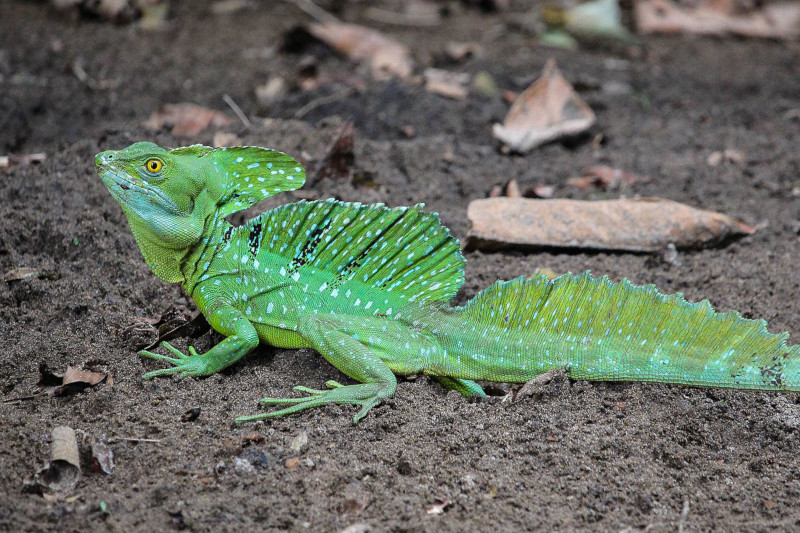
Plumed Basilisk Facts
- Firstly, the captivating term Plumed Basilisk serves as one of the common names for the amazing Basilicus plumifrons. Secondly, the animal also goes by such other common names as the double crested basilisk and the green basilisk. For a truly startling reason, however, some people also call the fabulous reptile by the term the Jesus Christ Lizard.
- Furthermore, the Swedish zoologist Carl Linnaeus became the first person to officially recognize the incredible species. This occurred in 1759, when he included the lizard in the 10th edition of his Systema Naturae. Several of the terms by which most individuals know the creature derive directly from its breathtaking and unique appearance.
- However, the nickname of the Jesus Christ lizard derives from an astounding ability. That’s because this reptile evolved the ability to walk of water, or at least to run across it. It does this when threatened. As it moves into the water, special sections of skin on its toes expand. This increases surface area allows it to skim across the water for up to 15 ft (4.6 m).
- Fortunately for those who appreciate the wonder of Nature, its population appears to be stable, at least for the moment. Therefore, the IUCN presently lists this fabulous animal as Least Concern. But, it nevertheless may face potential threats to its existence in the future. Habitat loss ranks as one, but it also faces the growing threat of climate change.
Related Articles
Plumed Basilisk Physical Description
The physical characteristics of the Plumed Basilisk may not be its most astonishing attribute. But these particular qualities nonetheless do merit attention. It must also be pointed out that, like many related animals, this reptile displays a moderate degree of the trait of sexual dimorphism.
Furthermore, in the case of this particular variety of reptile, that trait appears in the crests that develop on the body of the animal. That fact holds true in regards to the number of these displayed. The male develops a total of three of these. Meanwhile, only one such feature appears on the female.
Otherwise, both sexes of the remarkable creature closely resemble each other. Males and females attain an average body length measuring around 10 in (25 cm). But the tail greatly elongates the total length of the animal. That’s because the appendage adds an average of another 26 in (66 cm).
In addition, mature adults display the characteristic brilliant green coloring. In sharp contrast, though, several small, bluish-colored spots appear along the dorsal ridge. Additionally, its bright yellow eyes add yet another strong contrast to its extremely distinctive appearance.
- Kingdom: Animalia
- Phylum: Chordata
- Class: Reptilia
- Order: Squamata
- Family: Corytophanidae
- Genus: Basilicus
- Species: B. plumifrons
Plumed Basilisk Distribution, Habitat, and Ecology
Quite unfortunately for Nature enthusiasts, the mesmerizing Plumed Basilisk inhabits a somewhat restricted range. That’s because the unique animal only lives in a small portion of Central America. More specifically, it lives in a territory that extends from western Panama, through Nicaragua, to eastern Honduras. Sadly, it appears to exist nowhere else on the planet.
Given the region of the world in which it evolved, its natural habitat comes as no great surprise. This fascinating species lives in the widespread regions of tropical rainforest natural to the region. However, even there it has even more specialized habitat requirements. This occurs due to the fact that it spends the vast majority of its time in trees that grow close to a body of water.
In addition, much like many other lizards, the Plumed Basilisk evolved as an omnivore. Since it lives in the rainforest, it typically finds an abundance of food. The flora the reptile consumes principally consists of a variety of fruits and flowers. On the other hand, its hunted prey primarily consists of a mixture of small mammals, numerous insects, and even other small lizards.
But it itself has its own share of predators in the environment in which it lives. These mainly include such species as coati, opossums, and various types of snakes and birds. After mating, the female typically lays between 5 – 15 eggs. Further, these she lays in damp, warm soil or sand. Meanwhile, the male tends to be quite territorial. But the young immediately become independent once hatched.
Species Sharing Its Range
Check out our other articles on Breathtaking Primates of the World, Crowned Eagle, Tiger Leaping Gorge, Dawn Redwood, Blue Death Feigning Beetle, Great White Shark, Hermann’s Tortoise
